The Portuguese contribution that usually goes unheralded
Vindaloo, sorpotel, sweet Goan wine...Yes, the Portuguese brought all these to India. But there’s another Portuguese contribution that usually goes unheralded, writes Vir Sanghvi.
The Portuguese usually get a bum rap in discussions about Indian food. Talk about their contributions to our cuisine, and you’ll hear references to vindaloo, balchao, sorpotel, sausages, and disgusting sweet Goan wine. Nobody will mention that they brought the chilli to India and transformed our food forever.
But there’s also another Portuguese contribution that usually goes unheralded. And if you live in the western states of India (Maharashtra, Gujarat, etc) you will know that this is a far more significant contribution than is usually acknowledged.
We know that till the Muslims got here, Indians were not great bakers. We know also that those Indians who ate wheat (i.e. north of the Vindhyas, and not a lot in the East) tended to eat atta or wholewheat flour. Maida or refined flour came with the Muslims.
Our experiences with maida parathas and naans only start from the arrival of Muslim traders and rulers and when maida did penetrate south of the Vindhyas, it was as part of Muslim cuisine (i.e. the Malabar parotha of Kerala). Even now, in large parts of India, Muslims remain the best traditional bakers because of their skill at using maida. (My guess is that something like 80 per cent of the traditional bakeries in Bombay are Muslim-owned).
But Muslims in the north of India are not big on bread. If you go to a Muslim locality in Delhi, Lucknow or Allahabad and order a kebab or a korma, you’ll be served some kind of roti, paratha or naan with it. You won’t get a bun or a slice of bread on the side.
If, on the other hand, you go to Mohammad Ali Road or any such area where Muslim vendors ply their trade in Bombay, you may well get some bread with your curry. And some dishes — say the famous keema pav — are designed to be eaten with bread.
So why do Muslims in the west of India like bread more than Muslims in North India?
Well, that’s where the Portuguese enter the picture. As Lizzie Collingham points out in her authoritative Curry – A Biography, the Portuguese landed in parts of India (Cochin, Goa etc) where the locals ate rice. But they missed their crusty bread, and in any case, they needed bread for Holy Communion. They could find wheat flour in Goa but yeast was hard to come by. So they started using a few drops of toddy to ferment the dough and created the various Goan breads we know today: the round gutli, the flat pav, etc.
It is from Goa that bread first travelled to Bombay and became a staple among locals. By the time British arrived with their nasty white bread, the Portuguese-Goan pav had already been well established. And so British bread became an upmarket sort of dish, useful for making toast or sandwiches. But the food of the streets used pav, which could be sliced open to stuff an omelette into it or served alongside a spicy keema or a korma. And Bombay’s Goan community continued to use it as an alternative to rice.
But there was always a Hindus v/s the rest kind of divide. Pav became the food of the minorities (Muslims, Catholics etc) while Hindus stuck to traditional (and non-maida) breads like rotis, pooris, etc, even in Bombay. If you look at the snacks that developed in Bombay, bread of any kind hardly played a role, except in Christian and Muslim areas.
Then, gradually, the communal barrier was broken. The most famous example was the growth of pav bhaji stalls. I checked with Wikipedia, the most convenient if not most reliable source of information about Indian food habits, and discovered that it claims that pav bhaji was the food of Indian mill workers in 1850.




Catch your daily dose of Fashion, Health, Festivals, Travel, Relationship, Recipe and all the other Latest Lifestyle News on Hindustan Times Website and APPs.






